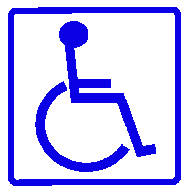



The Americans with Disabilities Act of 1990 (ADA) is the short title of United States (Pub.L. 101-
On September 25, 2008, President George W. Bush signed into law The ADA Amendments Act of 2008 (ADAAA). It is intended to give broader protections for disabled workers and "turn back the clock" on court rulings which Congress deemed too restrictive. The ADAAA includes a list of impairments to major life activities.
Title III - Public Accommodations (and Commercial Facilities)
Under Title III, no individual may be discriminated against on the basis of disability with regards to the full and equal enjoyment of the goods, services, facilities, or accommodations of any place of public accommodation by any person who owns, leases (or leases to), or operates a place of public accommodation. "Public accommodations" include most places of lodging (such as inns and hotels), recreation, transportation, education, and dining, along with stores, care providers, and places of public displays, among other things. This implies the presence of an ADA Compliance Kit in places of "public accommodations".
Most of the lawsuits filed under Title III of the ADA deal with the physical conditions or "accessibility" of physical places. Under Title III of the ADA, all "new construction" (construction, modification or alterations) after the effective date of the ADA (approximately July 1992) must be fully compliant with the Americans With Disabilities Act Accessibility Guidelines ("ADAAG") found in the Code of Federal Regulations at 28 C.F.R., Part 36, Appendix "A."
Perhaps even more importantly, Title III also has application to existing facilities. One of the definitions of "discrimination" under Title III of the ADA is a "failure to remove" architectural barriers in existing facilities. See 42 U.S.C. § 12182(b)(2)(A)(i).
This means that even facilities that have not been modified or altered in any way after the ADA was passed still have obligations. The standard is whether "removing barriers" (typically defined as bringing a condition into compliance with the ADAAG) is "readily achievable," defined as "easily accomplished without much difficulty or expense."
The statutory definition of "readily achievable" calls for a balancing test between the cost of the proposed "fix" and the wherewithal of the business and/or owners of the business. Thus, what might be "readily achievable" for a sophisticated and financially capable corporation might not be readily achievable for a small "mom-
There are exceptions to this title; many private clubs and religious organizations may not be bound by Title III. With regard to historic properties (those properties that are listed or that are eligible for listing in the National Register of Historic Places, or properties designated as historic under State or local law), those facilities must still comply with the provisions of Title III of the ADA to the "maximum extent feasible" but if following the usual standards would "threaten to destroy the historic significance of a feature of the building" then alternative standards may be used. Nonetheless, as Frank Bowe predicted when he testified as the lead witness on Title III in the Senate hearings leading up to enactment, the fact that Title III calls for accessibility in, and alterations to, many thousands of stores, restaurants, hotels, etc., in many thousands of communities across the U.S. means that this Title probably has had more effect on the lives of more Americans with disabilities than any other ADA title.
Housing
Most existing and new housing, even in the wealthiest nations, lack basic accessibility features unless the designated, immediate occupant of a home currently has a disability. However, there are some initiatives to change typical residential practices so that new homes incorporate basic access features such as zero-
Great Britain applies the most widespread application of home access to date. In 1999, Parliament passed Section M, an amendment to residential building regulations requiring basic access in all new homes. ("Doors to Be Swept Away in New Rules for Builders", Rachel Kelley, The Times, December 5, 1997.) In the United States, the 1988 Amendments to the Fair Housing Act added people with disabilities, as well as familial status, to the classes already protected by law from discrimination (race, color, sex, religion and country of origin). Among the protection for people with disabilities in the 1988 Amendments are seven construction requirements for all multifamily buildings of more than four units first occupied after March 13, 1991. These seven requirements are as follows:
1. An accessible building entrance on an accessible route.
2. Accessible common and public use areas.
3. Doors usable by a person in a wheelchair.
4. Accessible route into and through the dwelling unit.
5. Light switches, electrical outlets, thermostats and other environmental controls in accessible locations.
6. Reinforced walls in bathrooms for later installation of grab bars.
7. Usable kitchens and bathrooms.
(From Fair Housing First, a website sponsored by the U.S. Department of Housing and Urban Development).
In spite of these advancements, the housing types where most people in the United States reside —single-
The broad concept of Universal Design is relevant to housing, as it is to all aspects of the built environment. Furthermore, a Visitability movement begun by grass roots disability advocates in the 1980s focuses specifically on changing construction practices in new housing. This movement, a network of interested people working in their locales, works on educating, passing laws, and spurring voluntary home access initiatives with the intention that basic access become a routine part of new home construction.


George Herbert Walker Bush (born June 12, 1924) served as the 41st President of the United States from 1989 to 1993.
